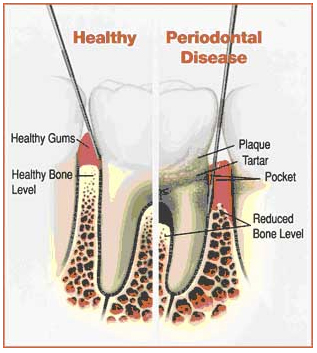|
 What is dental plaque?
What is dental plaque?
Dental plaque is a sticky almost invisible film of bacteria
or germs that is constantly forming on your teeth and gums.
If it is not brushed off after you eat, it combines with sugars
present in food particles to produce acids which attack and
harm your teeth. Plaque is the main cause of tooth decay and
gum disease.
How does plaque cause tooth decay?
 1.
Plaque turns food particles stuck between the teeth into acid
which attacks the tooth enamel. With repeated acid attacks,the
enamel wears away and a cavity is formed. 1.
Plaque turns food particles stuck between the teeth into acid
which attacks the tooth enamel. With repeated acid attacks,the
enamel wears away and a cavity is formed.
 2.Once
a cavity forms, the decay spreads to the next layer- the dentine.
But, if the cavity is filled by the dentist, the decay can
be stopped. 2.Once
a cavity forms, the decay spreads to the next layer- the dentine.
But, if the cavity is filled by the dentist, the decay can
be stopped.
 3.
If the cavity is not treated at the dentine stage, the decay
spreads deeper into the pulp and can be very painful. 3.
If the cavity is not treated at the dentine stage, the decay
spreads deeper into the pulp and can be very painful.
 4.
In the last stage, the decay spreads to the root and causes
an abscess, accompanied by severe pain. At this stage only
root canal treatment can save the tooth. In some cases, the
tooth may have to be extracted. 4.
In the last stage, the decay spreads to the root and causes
an abscess, accompanied by severe pain. At this stage only
root canal treatment can save the tooth. In some cases, the
tooth may have to be extracted.
What is gum disease?
Gum disease, technically known as periodontal disease, is
the major cause of tooth loss in adults. Periodontal disease
can affect one tooth or many teeth. It begins when the bacteria
in plaque (the sticky, colorless film that constantly forms
on your teeth) causes the gums to become inflamed.
In the mildest form of the disease, gingivitis, the gums
redden, swell and bleed easily. There is usually little or
no discomfort. Gingivitis is often caused by inadequate oral
hygiene. Gingivitis is reversible with professional treatment
and good oral home care.
Untreated gingivitis can advance to periodontitis. With time,
plaque can spread and grow below the gum line. Toxins produced
by the bacteria in plaque irritate the gums. The toxins stimulate
a chronic inflammatory response in which the body in essence
turns on itself and the tissues and bone that support the
teeth are broken down and destroyed. Gums separate from the
teeth, forming pockets (spaces between the teeth and gums)
that become infected. As the disease progresses, the pockets
deepen and more gum tissue and bone are destroyed. Often,
this destructive process has very mild symptoms. Eventually,
teeth can become loose and may have to be removed.
What are the signs of periodontal disease?
Four basic signs will alert you to periodontal disease are:
1) Bleeding gums during tooth brushing, flossing or any
other time.
2) Puffiness and swollen and bright red gums.
3) Recession- Gums that have receded away from the teeth,
sometimes exposing the roots.
4) Constant bad breath that does not clear up with brushing
and flossing.

How does gum disease start?
Healthy gums closely grip the sides of the teeth anchoring
them firmly in place, with the help of bone.
Unremoved plaque produces acids and bacterial irritants.
It also hardens into calculus, commonly called tartar which
presses around the gum line. As the gum becomes inflamed,
it may bleed. This condition is known as gingivitis.
If untreated, the infection spreads to the bone supporting
the tooth. Pus is formed, the bone begins to erode, and eventually
the tooth may be lost. The condition is called Periodontitis
or Pyorrhea.
|


 What is dental plaque?
What is dental plaque? 1.
Plaque turns food particles stuck between the teeth into acid
which attacks the tooth enamel. With repeated acid attacks,the
enamel wears away and a cavity is formed.
1.
Plaque turns food particles stuck between the teeth into acid
which attacks the tooth enamel. With repeated acid attacks,the
enamel wears away and a cavity is formed. 2.Once
a cavity forms, the decay spreads to the next layer- the dentine.
But, if the cavity is filled by the dentist, the decay can
be stopped.
2.Once
a cavity forms, the decay spreads to the next layer- the dentine.
But, if the cavity is filled by the dentist, the decay can
be stopped. 3.
If the cavity is not treated at the dentine stage, the decay
spreads deeper into the pulp and can be very painful.
3.
If the cavity is not treated at the dentine stage, the decay
spreads deeper into the pulp and can be very painful.  4.
In the last stage, the decay spreads to the root and causes
an abscess, accompanied by severe pain. At this stage only
root canal treatment can save the tooth. In some cases, the
tooth may have to be extracted.
4.
In the last stage, the decay spreads to the root and causes
an abscess, accompanied by severe pain. At this stage only
root canal treatment can save the tooth. In some cases, the
tooth may have to be extracted. 